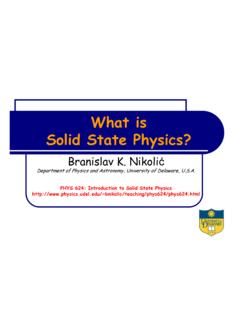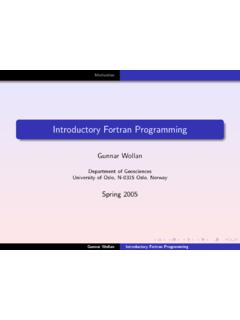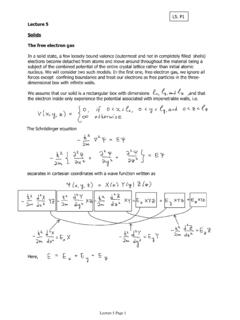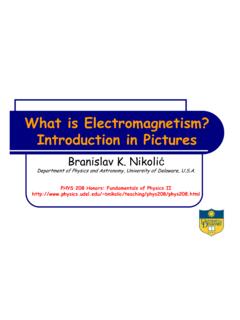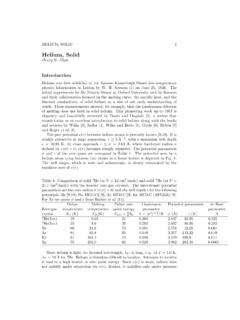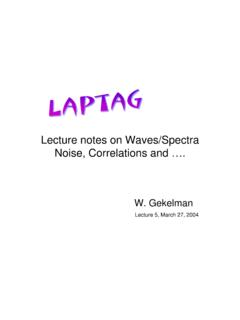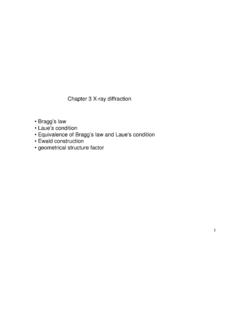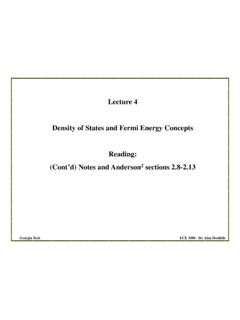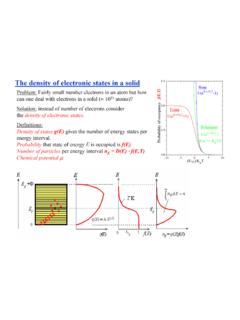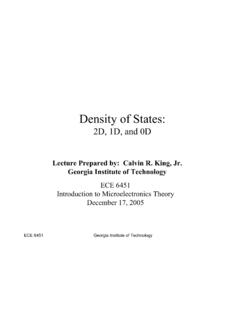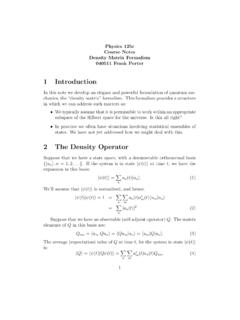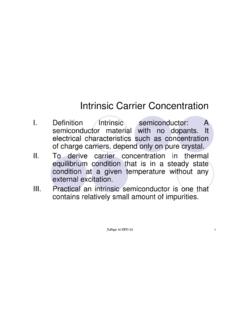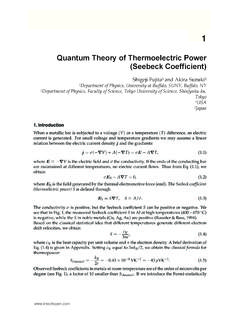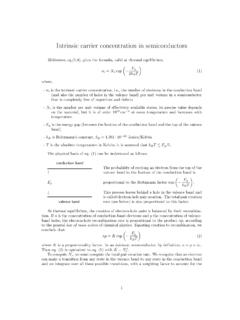Transcription of Bose Systems - Delaware Physics
1 Chapter 7 bose SystemsIn this chapter we apply the results of section to Systems of particlessatisfying bose -Einstein statistics. The examples are Black Body radiation (thephoton gas), atomic vibration in solids (the phonon gas) and alkali atoms intraps and liquid4He (a bose gas and fluid). Bosons in traps and the superfluidstate of liquid4He is believed to be an example of bose -Einstein condensationin which a large fraction of the Bosons occupy (condense into) the ground Body RadiationWe are all familiar with the idea that hot objects emit radiation a lightbulb, for example. In the hot wire filament, an electron, originally in an excitedstate drops to a lower energy state and the energy difference is given off asa photon, ( =h = 2 1). We are also familiar with the absorption ofradiation by surfaces. For example, clothes in the summer absorb photons fromthe sun and heat up. Black clothes absorb more radiation than lighter means, of course that lighter colored clothes reflect a larger fraction of thelight falling on black body is defined as one which absorbs all the radiation incidentupon it a perfect absorber.
2 It also emitts the radiation subsequently. If radia-tion is falling on a black body, its temperature rises until it reaches equilibriumwith the radiation. At equilibrium it re-emitts as much radiation as it absorbsso there is no net gain in energy and the temperature remains constant. In thiscase the surface is in equilibrium with the radiation and the temperature of thesurface must be the same as the temperature of the develop the idea of radiation temperature we construct an enclosurehaving walls which are perfect absorbers (see Fig. ). Inside the enclosureis radiation. Eventually this radiation reaches equilibrium with the enclosurewalls, equal amounts are emitted and absorbed by the walls. Also, the amountof radiation travelling in each direction becomes equal and is uniform. In this12 Statistical : Isothermal the radiation may be regarded as a gas of photons in equilibrium having auniform temperature. The enclosure is then called an isothermal enclosure of this type containing a small hole is itself a black radiation passing through the hole will be absorbed.
3 The radiation emittedfrom the hole is characteristic of a black body at the temperature of the photongas. The properties of the emitted radiation is then independent of the materialsof the wall provided they are sufficiently absorbing that essentially all radiationentering the hole is absorbed. This universal radiation is called Black everyday example of a photon gas is the background radiation in theuniverse. This photon gas is at a temperature of about 5 K. Thus the earth ssurface, at a temperature of about 300 K, is not in equilibrium with this earth is a net emitter of radiation (excluding the sun) and this is why it isdark at night and why it is coldest on clear nights when there is no cloud coverto increase the reflection of the earth s radiation back to the earth. A secondexample is a Bessemer converter used in steel manufacture containing moltensteel. These vessels actually contain holes like the isothermal enclosure of The radiation emitted from the hole is used in steel making to measure thetemperature in the vessel, by means of an optical model of black body radiation is a gas of non-interacting photonshaving energy related to their frequency and momentumpby =h = photons can be regarded as relativistic (massless) particles, our model alsorepresents a gas of relativistic finite mass particles for which 2=p2c2+m2c4 p2c2.
4 What is the energy density ,u=U/V, of this photon gas equilibrium? Howdoesu(T) depend uponT? As in a gas of non-relativistic particles we expect adistribution over the possible energies and frequencies ( =h ) available to thephotons, 0u( )d What is the spectral distributionu( )? In terms of wavelength this isu= 0d u( )whereu( ) is the energy density in wavelength range to +d . For a photongas in the enclosure depicted in Fig. what pressure does the photon gasChapter : Number of photons absorbed by the wall from angle isn dV=n(A cdtcos ).exert on the enclosure walls and what is the power per unit area, the emissivepower, emitted from the hole?To begin we answer these questions using kinetic theory and thermody-namics as far as possible. We then turn to statistical mechanics to completethe answer which forms a fine example of the interplay of thermodynamics andstatistical mechanics. Also quantum ideas entered Physics for the first timein the study of the photon gas.
5 Planck in 1901 found mathematically thathe could derive the observedu( ) if he summed over a discrete set of photonstates ( n=nh ) rather than integrating over a continuous set of states . Thismathematical result was interpreted physically by Einstein in 1905, using thephotoelectric effect, as discrete quanta of light (photons) each having energyh . Radiation Pressure and Emissive PowerWe considerNphotons in the enclosure of Fig. each having momen-tumpand energy =pc=h . The number density isn=N/Vgiving energydensityu=U/V=N /V. To obtain the pressure on the enclosure walls dueto the photon gas we note that a single photon striking the wall at an angle from the normal, that is absorbed, transfers a momentum to the wallpcos .( )The total number of such photons striking an areaAof the wall (assuming forthe moment they are all incident at angle ) in timedtisdN=ndV=n Acdtcos ( )HereA(cdt cos ) is the volume enclosing the photons each travelling at velocityc, that reach the wall in timedt(See Fig.)
6 The momentum brought up tothe wall in timedtis then,pcos dN=pn Acdtcos2 The pressure (force per unit area = rate of change of momentum per unit area)due to these photons arriving at angle isp( ) =1 Apcos dNdt=pcncos2 =ucos2 ( )To find the total pressure we need the fraction of photons striking the4 Statistical : at angle . Since the photons are randomly distributed in direction we canrepresent their arrival (and departure) by the hemisphere depicted in Fig. which the fraction arriving from the angle is proportional to the surfacearea of the hemisphere subtended by the angle , divided by the total area ofthe hemisphere,f( )d( ) =2 r2sin d 2 r2= sind .( )Here 2 r2is the area of the hemisphere. The total pressure is then,p= /20p( )f( )d = 4 /20ucos2 sin d orp=13u( )Herepis the final pressure ifuis the average energy have made two compensating errors of 2 here. Firstly, there is anequal number of photons in the gas going toward and away from the wall in thevolumedVin Fig.
7 Thus eq. ( ) should be divided by 2. However, inequilibrium there is an equal number of photons emitted as absorbed so thatthe total momentum transferred to the surface is twice that due to arrival ofphotons alone. These two effects cancel to leave eq. ( ) Emissive Power emerging from the hole in the isothermal enclosurein Fig. is defined as the power per unit area emitted from the hole. Tocalculate this we note that the energy brought up to a wall by a single photonis . The energy brought up to an areaAby photons impinging on the wall atan angle in timedtis, from eq. ( ), dN=1/2( n)Acdtcos the one half enters since one half of the photons indVof Fig. travel awayfrom the wall. The power per unit area is then ( ) =1A dNdt=1/2uccos 1In Chapter 3 we foundp= 2/3ufor a perfect gas of classical non-interacting is true also for the perfect quantum gases. The difference of 2 enters in the relationbetween the velocity and energy.
8 The pressure is really proportional to a product of momen-tum and velocity. In the relativistic gas case we have in eq. ( )n(pc) =uwhile fornonrelativistic particlesn(1/2mv2) =n(1/2pv) = : Heat : Carnot over all angles the total emissive power emerging from a hole in theenclosure wall isE= /20d f( ) ( ) =1/4cu( )Using kinetic theory arguments we have related the radiation pressureeq. ( ) and the emissive power eq. ( ) to the energy density of the photongas. We now employ thermodynamics to find the dependence Stefan - Boltzmann LawIn 1879 Stefan deduced the dependence ofuonTfrom the observedemission power and foundu=a T4( )whereais a constant. Boltzmann derived this relation using thermodynamicsin 1884. Boltzmann used an isothermal enclosure containing a hole as a source6 Statistical Mechanics.(and sink) for heat in a heat engine (see Fig. ). He then took the enginethrough a complete Carnot cycle (see Fig. ) and deduced the energy densityfrom the fact that the total entropy change in the reversible cycle must bezero.
9 We follow the steps in the cycle depicted in Fig. and briefly. Theisothermal enclosure is assumed sufficiently large that it can emit and absorbradiation without substantial change in (1) Open engine to black body at temperatureT1. Make an isothermalexpansion from volumeV1to volumeV2. Work done by the engine is W1=p1(V2 V1) =13u1(V2 V1)(i)Change in Internal energy is U1=u1(V2 V1)Heat added from Isothermal enclosure is Q1= U1+ W1=43u1(V2 V1)(ii)Step (2) Isolate engine from black body. Make isentropic expansion,TdecreasesfromT1toT2in (T1) u2(T2).Step (3) Lower temperature in black body toT2. Open engine to black an isothermal compression to point 4. Heat Q2is transferred tothe black body at (4) Isolate engine from black body. Make isentropic compression back fromT2toT1and the internal energy returns to its thermodynamic analysis of the cycle gives(1) Net work done by engine (conservation energy) W= Q1 Q2(iii)The net work done is also given by the area enclosed in the cycle in Fig.
10 Ifthe change in pressure is small, this is W= p(V2 V1) =13 u(V2 V1)(iv)(2) Second Law requiresdQ1=T1dS1 entropy change in Step (1)dQ2=T2dS2 entropy change in Step (2)Chapter , since the steps are reversible, the total change in entropy must be zero atthe end of the cycle,dS1= W Q1= 1 Q2 Q1= 1 T2dS2T1dS2=T1 T2T1= TT1 From (ii) and (iv) W Q1=14 uu1= TT1andu=aT4 Thus the Stefan - Boltzmann law can be derived using thermodynamicsalone and the emissivity isE=14cu=14ca T4= T4( )Here = 10 7joules/m2K4sec is Stefan s constant. We cannot,however determineaor thermodynamically or the spectral distribution. Forthese we turn to statistical The Spectral Distribution(a) Historical AsideThe distribution of energy density over wavelength,u( ), in a photon gashaving total energy densityu= 0d u( )( )holds a special place in the development of quantum mechanics. Wien proposed,making specific assumptions about the absorption and emission of photons atthe enclosure walls, that the spectral distribution should take the formu( ) =c1 5e c2/ T( )wherec1andc2were undetermined constants.

